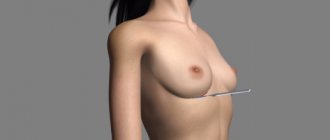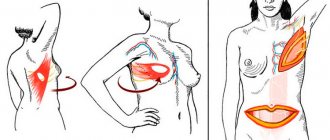Breast plastic surgery (mammoplasty) is one of the most popular among women. It helps to give the breasts a young and beautiful look and the desired shape.
Women who decide to undergo breast surgery most often complain of the following problems:
- pathologically small breast size;
- the chest drops strongly, maintaining its size;
- the breasts increase sharply in size and remain firm;
- breasts become smaller after breastfeeding.
Mammoplasty will help solve all these problems using certain methods.
Options for breast correction
The capabilities of modern plastic surgery allow us to offer several types of mammoplasty:
- Mastopexy (breast lift)
- endoprosthetics or otherwise augmentation mammoplasty (consists of increasing breast size)
- reduction (consists of reducing breast size)
- reconstructive (restoration of a missing breast due to a previous removal operation)
- correction of breast shape, areola
- correction of an inverted nipple (if there are no pathologies that provoked this phenomenon)
In addition, types of interventions can be combined with each other - for example, a lift can be accompanied by endoprosthetics.
Types of surgery
- restoration of breast shape
- increase in breast size
- breast reduction
Plastic surgery for breast augmentation is the most popular among women. A large and beautiful bust is the dream of every woman. And if nature did not reward this, or the breasts have lost their shape, the solution is to seek help from a surgeon.
Breast enlargement occurs through the installation of breast implants. They are the ones who influence the cost of the operation. The manufacturer and the quality of the material matter.
The implant can be installed in the armpits, under the mammary gland, or in a combined way. The most common is a combined technique, in which the implant is partially placed in the armpit and partially under the gland.
Reduction mammoplasty is performed when large and full breasts become a problem. This type of surgery is voluntary and is most often performed to eliminate painful conditions. This may include pain in the neck or back, in the chest, difficulty breathing, or curvature of the spine.
Indications for surgery
You can now answer the questions your plastic surgeon will ask you during your appointment:
- Do you feel like your breasts are too small?
- Do you feel insecure in revealing or tight-fitting clothes?
- Are you having difficulty choosing a suit? Do the skirt or trousers fit your figure, but is the jacket too big?
- Have your breasts become less firm and out of shape after childbirth and/or breastfeeding?
- Have you lost weight and then the shape of your breasts has changed?
- Are you worried about breast asymmetry?
- Do you experience discomfort from having too large breasts, are you annoyed by unflattering comments about curvy figures?
If you answered yes to at least one of the questions, you may need to visit a plastic surgeon and consider the option of surgery.
Rehabilitation period
Breast augmentation surgery is not a particularly traumatic type of surgery. Therefore, the patient can be discharged the next morning. At first there will be pain, and the doctor will prescribe analgesics. Bruising will begin to subside in about 7 days.
Most of the swelling will subside within a month, but it will only go away completely within a year. In just 1-2 months you will be able to engage in physical exercises, but without sudden swings of your arms.
It is important that breast plastic surgery is performed by an experienced plastic surgeon, and that the patient strictly follows all recommendations. This will eliminate complications and speed up the rehabilitation process.
How is the operation performed?
The operation is performed under endotracheal anesthesia and lasts on average about 2 hours. Preparation for the intervention includes a thorough diagnosis: general clinical tests, ECG, visit to a mammologist, ultrasound examination of the mammary glands, examination by a therapist.
The operation can be performed in various ways depending on the end goal. If endoprosthetics is chosen, the intervention consists of the introduction of implants, which are selected in advance at a face-to-face consultation together with a plastic surgeon. This is carried out with the obligatory consideration of not only wishes, but also anatomical features.
Breast augmentation in Ufa
Benefits of using dentures
- they don't lose volume
- you can choose any size
- All dentures come with a lifetime guarantee
- The average person cannot distinguish modern prostheses from ordinary breasts
- in case of severe asymmetry of the mammary glands, you can choose prostheses of different volume, size and shape
Indications for surgery
- Dissatisfaction with breast volume
- Dissatisfaction with the shape of the mammary glands
- Marked asymmetry of the mammary glands
- Minor ptosis of the mammary glands
Contraindications for surgery
- Inflammatory skin diseases in the area of surgical access
- Unfinished lactation
- Presence of malignant breast tumors
- Presence of infected breast cysts
- Severe diseases of internal organs
Operation technique
Augmentation mammoplasty surgery is performed under general anesthesia.
There are three main ways to install prostheses: 1. Installation through the axillary access (axillary).
It is considered the most labor-intensive method. The incision is made in the armpit area and after complete healing it is practically invisible. When installing prostheses through the axillary approach, endoscopic technology is used.
2. Installation of prostheses through the areola.
A skin incision is made along the border of dark and light skin of the nipple-areolar complex. As a rule, the scar after healing is also practically invisible. The disadvantage of this method is the risk of lactation disorders. According to research, the share can reach up to 15%.
3. Submammary access or access along the breast fold.
A 3-4 cm long incision is made along the inframammary fold. Prostheses are installed under the pectoralis major muscle or, in some cases, directly under the thickness of the mammary gland. After installing the prostheses, the wound is sutured, each layer separately. Cosmetic stitches are applied to the skin. Sometimes there is a need to install drainage (tubes). In our work, we install drains in approximately 5% of all operations.
The duration of the operation can be from 50 minutes to 2 hours.
Rehabilitation
Augmentation mammoplasty (augmentation mammoplasty) is a rather serious and complex operation. It requires strict adherence to all recommendations. It is mandatory to wear compression garments for 4 weeks. Compression garments after mammoplasty are necessary, first of all, to prevent displacement of the prosthesis. The prosthesis must be in one position. Further, at the discretion of the attending physician. After surgery there are serious restrictions on physical activity. You should not lift weights for the first two weeks, as there is a risk of injury to internal structures.
You need to remove the sutures within 10-12 days, if you have removable sutures. It is preferable to use self-absorbing sutures, which do not need to be removed.
Prices for mammoplasty surgery
| Breast augmentation (both breasts) | 38 000,00 |
| Breast augmentation (one breast) | 22 000,00 |
| Breast reduction (reduction mammoplasty) (both breasts) | 60 000,00 |
| Breast reduction (reduction mammoplasty (one breast) | 60 000,00 |
| Nipple correction | 10 000,00 |
| Areola correction | 10 000, 00 |
| Periareolar vertical breast lift (mastopexy) | 20 000,000 |
| Periareolar vertical breast lift (mastopexy) according to Legeau | 60 000,00 |
| Mastectomy | 20 000 |
| Removal of accessory mammary gland | 10 000,00 |
| Removal of implants | 20 000, 00 |
| Periareolar breast lift (mastopexy) | 30 000,00 |
| Breast reoperation | 10 000, 00 |
View full price list
Breast surgery: red light
Conventional surgeons and psychologists oppose breast mammoplasty, arguing that breast enlargement does not make a woman happy and can have serious consequences for the body. The fact is that the implant may not take root, and this happens quite often, which will require repeated surgery to remove them. In addition, abusing general anesthesia is also very dangerous; cases of poor tolerability of the procedure have been proven. Another argument against it is that the breasts may lose sensitivity and this is often irreversible. Opponents of mammoplasty recommend first contacting a psychotherapist, since sometimes the problem is not breast size at all.
Be that as it may, each woman decides individually whether to undergo breast surgery or not; the main thing is that she should be familiar with all the advantages and disadvantages.
Foreign and domestic stars often resort to such operations; we don’t know whether this is due to maintaining their image or simply a desire to distinguish themselves. But we bring to your attention three striking examples of celebrity mammoplasty:
Anastasia Zavorotnyuk
The 45-year-old Russian star does not confirm her appeal to plastic surgeons, however, it is impossible not to notice it. The experiment turned out to be successful, curvy shapes look quite natural.
Pamella Anderson
The Hollywood celebrity can be called a pioneer of mammoplasty; perhaps, it was with her that many Russian women began to want to undergo breast surgery. At 49 years old, Pamella has undergone breast correction several times and has finally brought it to perfection; now her breasts look beautiful and realistic.
Christina Aguilera
The American singer and actress is 36 years old, and she had her very first operation at the age of 18. Thanks to the surgical transformation, Christina’s bust increased by two sizes at once and many believe that this is what added to her popularity. Aguilera underwent repeat mammoplasty relatively recently, after giving birth, to correct her shape.
Breast surgery
Breast plastic surgery allows you to enlarge or reduce the size of the mammary glands, correct their sagging (ptosis) and asymmetry, the size and position of the nipple-areolar complexes, or completely recreate the mammary gland after its removal:
Augmentation mammoplasty
– breast augmentation surgery using silicone implants or lipofilling (see below). Depending on the initial situation, we use implants from various manufacturers in our work, however, giving preference to nanotextured implants of the latest VI generation of production, the safety of which has been proven by a number of serious clinical studies. The operation can be performed either from an access in the inframammary fold or along the border of the areola, and the use of modern devices makes it possible to perform incisions of minimal length, leaving almost invisible scars. Rehabilitation after surgery takes no more than 1 month; you can return to full physical activity after 2-3 months.
Reduction mammoplasty
– an operation to reduce the volume and size of the mammary glands, which is performed when they are overdeveloped, which is usually combined with significant sagging. The operation allows you not only to get neat, harmonious breasts without sagging, but also to get rid of other problems associated with large volumes of mammary glands, such as pain in the back and shoulder girdles, maceration of the skin in the chest folds, limitation of physical activity, difficulties in choosing underwear and clothes. The intervention is relatively easily tolerated by patients and has a short rehabilitation period.
Breast lift or mastopexy
. Sagging (ptosis) of the mammary glands is a common phenomenon that occurs both after pregnancy and lactation, and with age-related atrophy of mammary gland tissue, and is due to the fact that the supporting apparatus of the mammary gland (Cooper's ligaments, elastic properties of the skin) under these conditions stretches and loses the ability to resist gravity. Since at the moment there are no effective ways in world practice to restore the properties of the breast support system, the only effective way to correct ptosis is to reduce the excessively stretched skin cover and redistribute the breast tissue - breast lift (mastopexy). Depending on the initial situation, the lift is performed using a vertical skin cut, or, more often, an inverted T cut is used, when the horizontal part of the scar is hidden in the inframammary fold. In situations where it is necessary to replenish the lost volume, most often of the upper slope of the mammary gland, breast lift is combined with a simultaneous increase in their volume using implants.
Breast reconstruction
— reconstruction of the mammary gland to replace the one lost as a result of various reasons (most often after radical oncological operations), possible in several options:
- in two stages using first a special stretching device (expander), which allows you to create a volume of skin and superficial soft tissues sufficient to reliably cover the permanent prosthesis, and then a silicone implant;
- by lipofilling, i.e. transplantation of specially collected and processed own adipose tissue from other parts of the body to the breast area, which allows you to get warm, soft breasts, consisting exclusively of your own living tissue, as well as improve the quality of existing scars. According to generally accepted standards, no more than 150–200 ml of adipose tissue can be safely and reliably introduced into the breast area in one lipofilling session, so in most cases, such reconstruction requires several lipofilling sessions. To achieve optimal symmetry, a breast lift with augmentation/reduction of the healthy breast is often required. The use of the technique is also limited by the presence of sufficient volume of fat depots in the patient. Lipofilling is often combined with simultaneous lipofilling with the formation of a submammary fold, as well as a new areola, and is used to correct tubular (tubular) breast deformities and breast contouring (for example, to reduce the interbreast distance when enlarging the mammary glands).
- by moving sections of surrounding tissue on a vascular pedicle - flaps - to the mammary gland area. The most commonly used flaps for breast reconstruction are the latissimus dorsi muscle (LD flap or TDL) and the rectus abdominis muscle flap (TRAM flap). This is the most traumatic and complex method of reconstructing the mammary gland, indications for which arise when there is a severe deficiency of soft tissue in the area of the chest wall and/or the impossibility of using other techniques.
Correction of the shape of areolas and nipples
– an operation to change the shape and size of the nipples and areolas when they are overstretched, with so-called “areolar hernias” that occur as one of the manifestations of tubular deformation of the breast, as well as in order to achieve symmetry. The operation is performed both in combination with lifting and breast augmentation, and in an isolated version. In this case, it is possible to perform the intervention under local anesthesia and on an outpatient basis.
Elimination of gynecomastia
– removal of overdeveloped mammary glands in men. In case of true gynecomastia, when the mammary glands are enlarged due to hypertrophy of the glandular tissue of the gland, excision of the mammary glands with contour plastic surgery is performed from a small incision along the edge of the areola. For false gynecomastia, when enlargement of the mammary glands is predominantly associated with excessive local hypertrophy of adipose tissue, minimally invasive correction by liposuction is possible. However, most often there is a combination of both factors, which accordingly requires a combined approach to treatment. The diagnosis is clarified by ultrasound; the intervention can be performed under local anesthesia; the rehabilitation period usually takes no more than 2-3 weeks.










